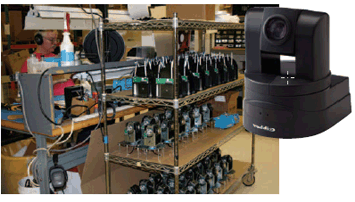Vaddio Sees Ease Of Use As The Future Of Robotic Camera Technology
Videoconferencing is considered a major growth area for systems integrators; manufacturers large and small are making innovative solutions to bring virtual meetings to more clients.
One of those companies is Vaddio, based in Minneapolis, MN, and founded by industry veteran Rob Sheeley. Vaddio is a manufacturer and OEM distributor of specialty PTZ cameras and high-end camera control systems. Whether its products are used in the broadcasting, audiovisual, or videoconferencing industry, the Vaddio mission is simple: making camera technology easy to integrate, automate, and use.
Robotic HD cameras evolve at Vaddio, a company with roots in videoconferencing.INSET: Vaddio’s ClearVIEW HD-18 is the first robotic camera built in the U.S. in 25 years.
One glance at Rob Sheeley’s background gives clues to Vaddio’s unique company philosophy, and the evolution of robotic HD cameras. For more than 25 years, Sheeley’s been at the forefront of product development and marketing, with careers at RCA and Honeywell. In the 1980s, Seeley started as an integrator with a Midwest regional company, Acoustical Innovations Systems. “We were one of the first videoconferencing suppliers then,” he said. The company made a name for itself with systems for Ohio State University and the City of Houston in 1986. Popular applications were videoconferencing systems for remote arraignments in city and municipal courts.
Sheeley began to see the need for “custom products for specific jobs” and started designing peripherals that helped integrate technology seamlessly into rooms. A new furniture company, Acoustic Components, was born. “AV dealers all over the country were buying products from us,” he said, “and I understood the dynamic [of application-specific solutions].”
During that time Sheeley started collaborating on custom cameras and document cameras for clients such as pharmacies and retail operations. His wood furniture business, which started in the garage, moved to a real store. Thousands of pieces of furniture were sold: “It was the right product at the right time.”
Before long, videoconferencing systems were rolling out in greater numbers and the custom electronics, peripherals, and furniture to tie it all together, evolved into Vaddio. It was perfect timing, which itself is artistry for Sheeley: “You’re only as competitive with how fast you can react to changes in the market.”
With advances in content creation, collaborative professional environments, smaller travel budgets, and the global spread of H1N1, there are more and more requests for remote meeting systems.
In the college seminar room, Vaddio products like the ClearVIEW HD-18 can automatically track a professor walking from the podium to the center of the lecture hall. “Technology only works if it is transparent,” Sheeley explained. The professor can wear a wireless mic, the podium has a preset, the tracking is activated, and the remote students are seeing everything shown in the classroom, from internet clips to whiteboard video.
Propelled by the popularity in videoconferencing, Sheeley sees the wider industry ready for robotic cameras: “We’ve experienced a rapid acceleration from the ‘presentation environment’ to the ‘collaboration environment.’”
Besides classrooms and boardrooms, Vaddio systems can be found in some of the most high-profile venues in the world, such as the White House Press Office and Cleveland’s Rock and Roll Hall of Fame.
Vaddio’s ClearVIEW HD-18 is not just the only multi-format PTZ camera that delivers component HD in 1080p, 1080i, or 720p and simultaneous SD video, it is also the first robotic camera built in the U.S. in 25 years, a genuine source of pride for the company.
To communicate all of the nuances of the people on camera, hightorque, micro-stepper precision robotics enhance the HD-18’s performance with pan/tilt operation for accurate camera movement and control. It’s compatible with any Polycom or Tandberg videoconferencing codec.
But don’t let its intelligence fool you, Sheeley warns. The HD-18 is easy to integrate and to use. It must be, to offer value, client satisfaction, as well as evolve our industry. “Technology evolution is about how intuitive it is, how easy it is to adopt,” Sheely said. “The internet existed, but it took a browser to make the web what it is today.”











